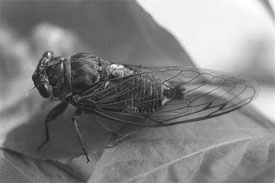Cicadas invade Quad, leave songs and exoskeletons behind
- September 13, 2005
- |
- Kevin Teets, Senior Reporter
- Section: News
You won’t find information about them in the admissions guide to UTM.
They probably didn’t help UTM place so well in the 2006 edition of America’s Best Colleges.
But they are certainly making their presence known. Step out in the quad and listen to the many cicadas as they sing in their efforts to attract a mate.
Entomologist and UTM Biology professor Dr. Randy Cate says that our visitors in the quad are called the dog day cicadas. They are a species of cicadas that have a life cycle that usually lasts for at least four years.
For about the last month of their life the male cicada can be heard singing its song to the females by vibrating a membrane found on its abdomen. But, the cicada has an interesting life cycle that begins well before its time to sing.
According to Cate, after the cicadas mate the female will prepare to deposit her eggs. “The female splits the twigs on trees and bushes and puts her eggs in those twigs,” Cate says. In a few days the eggs will hatch and at this point are referred to as a nymph.
The nymph will then tumble to the ground and live under the ground for up to four years as it sucks out the sap from the roots of trees.
“They can live up to six feet deep under ground,” Cate says. “In the cold of the winter, the cicadas will go down further into the ground.”
After living in the ground for nearly four years, the cicada emerges above ground and usually crawls onto a tree or fence post and sheds its exoskeleton. Now the cicada has wings and is considered to be an adult. It will live in its adult form for usually no longer than a month. This is when the males can be heard singing.
Cate says that the dog day cicadas emerge every year in the late summer. There are other species of cicadas such as the 17-year cicada that only emerges after a 17 year life cycle. This cicada is considered to be the longest living insect in the U.S.
Those walking through the quad should enjoy the songs of the dog day cicada while they can. The cicadas are beginning to die off already. When this happens the only song they make is the crunch that one hears underneath their foot.

The dog day cicada, Tibicen pruinosa, appears every summer late in the season. They are characterized by their loud buzzing noise, which is made by the male in order to attract a mate. Cicadas, often confused with locusts, shed their exoskeletons after they sing.